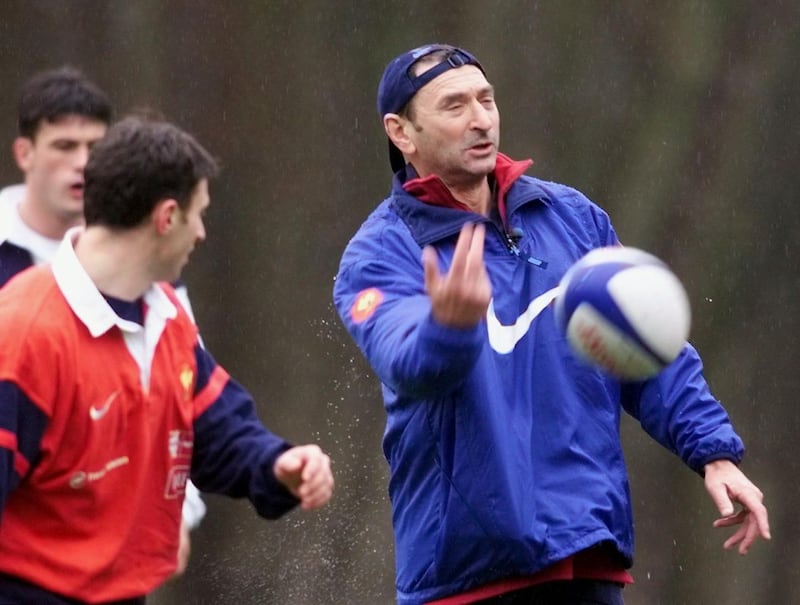Rugby is a game containing many abstract lines. The offside line, the line of touch and the gainline are just some of the invisible borders that exist in rugby’s lexicon.
In recent years, a new line has emerged, thanks to the fear that concussion has brought into contact sports – the tackle line.
The RFU looked to bring a version of it into their amateur game last season, mandating that all tackles were to be below the waist line. This decision was made with zero consultation between their clubs, coaches or players. In their panic surrounding concussion the RFU published a hastily constructed poster aimed at educating the great unwashed regarding their new law.
The poster featured two female players with a red line drawn across the upright attacker’s waist.
The Counter Ruck: the rugby newsletter from The Irish Times
Leo Cullen praises solution-focused Leinster for fighting back after blistering Bath start
Leinster demolish 14-man Bath to go undefeated in Champions Cup pool stages
‘When we’re poor, we’re being very poor’: Munster rue sloppiness in Northampton defeat
The madness was that the tackler in the poster was portrayed in the most dangerous of positions. With downcast eyes not focusing on the target area, that forced an arched back like the Sydney Harbour Bridge. The defender’s head was positioned in front of the ball carrier in a shocking and dangerous position. Tackle technique 101 that should be coached to under 8s is having the defender’s head safely behind the attacker. The poster on safety guaranteed the defender’s head would collide with the attacker’s hips, elbows or knees.
The outcry from the English rugby community regarding the danger and ignorance on display was long and loud. It was a huge PR disaster and a prime example of the lack of thought on this entire topic. The RFU were forced into a climbdown. The offending poster was binned, the rules and their wording were changed, with the proposed tackle height changing from “waist” to the “base of the sternum”.
A few weeks ago Rugby Australia announced the start of a detailed two-year trial to set the base of the sternum as the legal height for contact on the ball carrier in the tackle for all teams below Super Rugby level.

I am a supporter of having the base of the sternum as the height where contact can be made in the tackle. However, this quagmire of new lines for contact from individual nations seemingly without co-ordination from World Rugby has made these essential trials far more complicated than they should have been.
The individual nations can see the problem that the fears of concussion is causing at the grassroots of the game and have become frustrated at World Rugby’s lack of leadership. As has happened so often in the past, the individual nations are taking matters into their own hands. Ireland, Wales and France have all committed to their own version of the new contact line in the lower levels of the game.
Theories on why World Rugby has been so tardy to act abound. One theory given to me by a rugby-loving lawyer was that the class action that is currently being prosecuted before the courts, regarding the effects of concussion on a number of former players in the northern hemisphere, has limited Word Rugby’s ability to act as a governing body to change laws that may mitigate concussion in the game.
The lawyer suggested this may be because if World Rugby were to change multiple laws that were seen as actions to prevent concussion, in court it could be argued that the changes were an admission of guilt that the game did not do enough in the past to protect players.
Interestingly, he noted that a high-profile legal case in Australia, involving an individual who suffered concussions in rugby league and who took action against the governing body, in circumstances very similar to those being prosecuted against rugby in the north, had failed.
[ Be in no doubt, all you nostalgists - rugby union was woeful in the amateur eraOpens in new window ]
It appears that World Rugby’s lack of action has forced individual national bodies to act, with what has been until now great haste and little thought.
While I am in favour of having the base of the sternum as the specific height for contact point on the attacker in the tackle, the implications of this across the game are vast. Perhaps the most striking is that it will make it almost impossible for a second defender to join the tackle.
In the past, the mantra for tackle technique coaching was “chop and top”. The first player makes contact low to try to chop the attacker to the ground. The second defender attacks the ball at the top, to stop the attacker offloading.
Remember that offloading in attack destroys defensive systems.
Smart coaches will revive the coaching techniques of the great Toulousain Pierre Villepreux, who in the 1980s advocated what he termed “channel overlaps”. That is when an attacking team supports from depth and floods a single defender’s channel with multiple players. With short, sharp passes, the attackers hit the same hole in the defensive line again and again.

While all of this could be very positive for the game, the law of unintended consequences will be an ever present elephant in the game across the two-year trial.
For example, as this new law stands, defenders on their try line will be unable to legally tackle any attackers who use low body height as they drive for the line. This attacking situation makes it physically impossible for the defenders to make contact below the sternum because the attacker is bent over at the waist. A problem that could place the tackler at risk of a head knock.
[ Mind the gap: World Rugby has a decision to make on laws governing the lineoutOpens in new window ]
In the past the slowness of law change within rugby has made the Vatican look like a bunch of rabid radicals. The introduction of an imaginary line that sets the legal height for all tackle contact has been created with such unprecedented speed that no one can predict the full ramifications of this profound law change.
It is fair to predict, that in time, this law will radically reshape how rugby is played at all levels of the game. Possibly as soon as the next World Cup.






